Immune checkpoint pathway is the focus of current cancer research, and one of the best-characterized checkpoint proteins is PD-1. T-cell activation is suppressed by the binding that occurs between PD-1 and its ligand PD-L1 and/or PD-L2, and allows cancer cells to escape from the body’s immune surveillance. This kind of mechanism encourages the idea that neutralization of the PD-1 pathway could help in re-engaging the immune system to combat cancer.
In the past few years, multiple lines of anti-PD-1 drugs have been formulated, and many have demonstrated significant potential in recent clinical trials. Patients afflicted with renal cell carcinoma, melanoma, hematological cancers, or non-small cell lung cancer (NSCLC) have been shown to respond positively to this therapy.
ACROBiosystems offers a complete range of PD-1 related products for researchers to study and target the PD-1 pathway.
PD1 Pathway Targets
| PD-1 |
PD-L1 |
PD-L2 |
PD1:PDL1 ELISA Assay Pair |
Key Features
Biotinylated PD-1 Pathway Proteins
ELISA
The assay technique, ELISA, is routinely used for characterizing interactions between proteins. It is usually applied in initial high-throughput screening, or HTS, of compound library. A series of pre-biotinylated PD-1 pathway proteins has been developed by ACROBiosystems. Biotinylated proteins can act as two-way antibodies for capture as well as detection in ELISA assays. Compared to traditional antibodies, the biotinylated proteins show higher specificity and detection sensitivity.
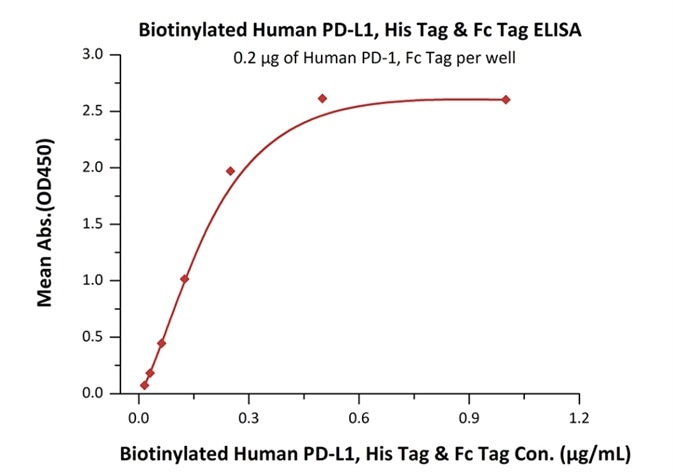
Figure 1. Immobilized human PD-1 (Cat. No. PD1-H5257) at 2 μg/mL (100 μL/well) can bind to biotinylated human PD-L1, His & Fc tag (Cat. No. PD1-H82F3) with a linear range of 0.01—0.25 μg/ml.
Suggested Pairs
| |
Product Description |
Cat. No. |
Species |
Structure |
| Pair 1 |
Human PD-L1 / B7-H1 Protein, Fc Tag, low endotoxin |
PD1-H5258 |
 |
 |
| Biotinylated Human PD-1 / PDCD1, His Tag & Fc Tag, Avi Tag (AviTagTM) |
PD1-H82F2 |
 |
 |
| Pair 2 |
Mouse PD-L1 / B7-H1 Protein, Fc Tag |
PD1-M5251 |
 |
 |
| Biotinylated Mouse PD-1 / PDCD1, Fc Tag, Avi Tag (AviTagTM) |
PD1-M82F4 |
 |
 |
| Pair 3 |
Human PD-1 / PDCD1 Protein, Fc Tag (HPLC-verified), low endotoxin |
PD1-H5257 |
 |
 |
| Biotinylated Human PD-L1 / B7-H1, His Tag & Fc Tag, Avi Tag (AviTagTM) |
PD1-H82F3 |
 |
 |
| Pair 4 |
Mouse PD-1 / PDCD1 Protein, Fc Tag |
PD1-M5259 |
 |
 |
| Biotinylated Mouse PD-L1 / B7-H1, Fc Tag, Avi Tag (AviTagTM) |
PD1-M82F5 |
 |
 |
A PD-1[Biotin]: PD-L1 Inhibitor Screening Kit (Cat. No. EP-101) has been developed to further simplify research processes. This assay uses a simple colorimetric ELISA platform, which determines the binding between the in-house developed biotinylated PD-1 protein and the immobilized human PD-L1 protein. This product is optimized for rapid and high-throughput screenings of putative PD-1 and PD-L1 inhibitors.
| Molecule |
Cat. No. |
Product Description |
Species |
Size |
| PD-1 & PD-L1 |
EP-101 |
PD-1[Biotin]: PD-L1 Inhibitor Screening Pair |
 |
96 tests, 480 tests |
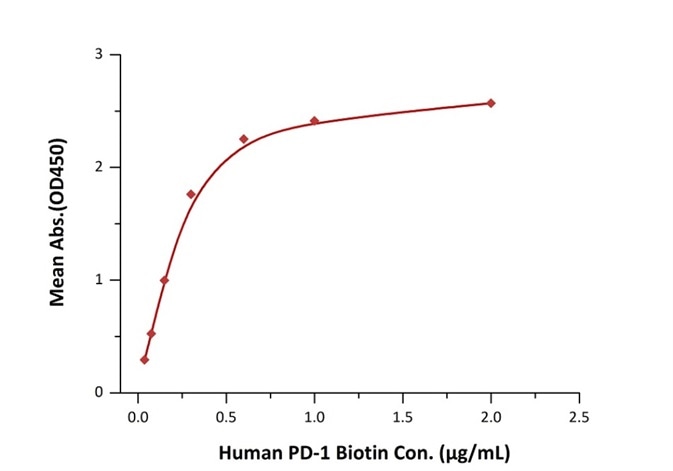
Figure 2. Immobilized PD-L1 at 2 μg/mL (100 μL/well) can bind biotinylated human PD-1 with a linear range of 0.038 - 0.6 μg/mL when detected by Streptavidin-HRP.
![Inhibition of PD-1-PD-L1 binding by an anti-PD-1 neutralizing antibody is measured by the PD-1 [Biotinylated]: PD-L1 Inhibitor Screening ELISA Assay Pair (Cat. No. EP-101).](https://www.news-medical.net/image-handler/picture/2018/11/Job_5567_Art3_Pic3.jpg)
Figure 3. Inhibition of PD-1-PD-L1 binding by an anti-PD-1 neutralizing antibody is measured by the PD-1 [Biotinylated]: PD-L1 Inhibitor Screening ELISA Assay Pair (Cat. No. EP-101).
FAC Sorting
Biotinylated proteins can be used together with fluorophore-tagged SA for detecting/isolating cells that express specific surface markers. In a US patent titled “ANTI-PD-1 ANTIBODIES AND METHODS OF USE THEREOF” (US patent 20160159905), the authors from Pfizer Inc. applied ACROBiosystems’ biotinylated PD-L1 (Cat. No. PD1-H82F3) as well as biotinylated PD-L2 (Cat. No. PD2-H82F6) to contend with candidate antibodies in a binding assay against PD-1 protein expressing cells. This assay offers measurement for the binding activity of the corresponding antibodies.
Biopanning
Biopanning is progressively becoming one of the best mainstream methods for developing antibodies. AviTagTM biotinylated proteins can be applied with SA-coated magnetic beads/surfaces in biopanning. This provides a much better option when compared to chemically biotinylated or non-biotinylated proteins because it offers uniformed antigen presentation and higher coating density.
It is worth noting that the Fc tag is not usually preferred for these kinds of experiments because it produces false positive results. ACROBiosystems has developed AviTagTM PD-1 pathway proteins with just His tag attached. These products are recommended specifically for biopanning.
| Molecule |
Cat. No. |
Species |
Structure |
Purity |
Features |
| PD-1 |
PD1-H82E4 |
 |
 |
 |
 |
| PD-L1 |
PD1-H82E5 |
 |
 |
 |
 |
| PD-L2 |
PD2-H82E8 |
 |
 |
 |
 |
Cell-Based Assay Verified Proteins
Being a professional supplier of pharmaceutical companies, ACROBiosystems has established a cell-based assay platform to validate the target protein’s activity, which provides cell-based experiment data support for screening drugs.
ACROBiosystems employed human PD-1 overexpressed 293 cells that were developed in-house in flow cytometry assay and cell-based ELISA, and the outcomes demonstrated good performance of PD-L1 (Cat. No. PDI-H5258) and PD-L2 (Cat. No. PD2-H5251) binding to PD-1.
FACS Analysis of PD-L1 or PD-L2 Binding to Cell Surface PD-1
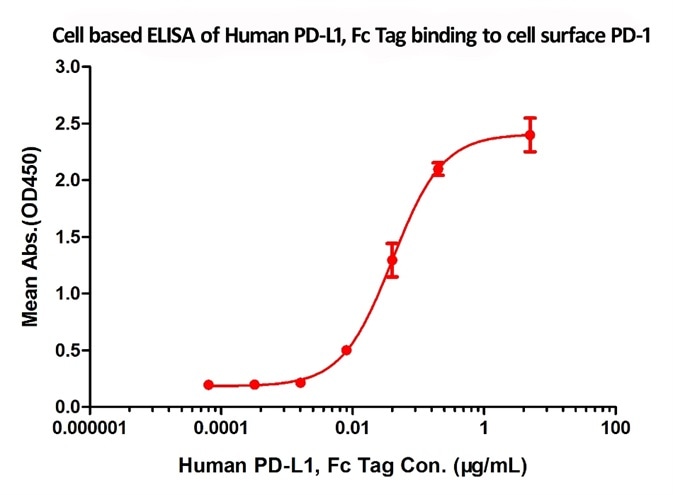
Figure 4. Flow Cytometry assay shows that recombinant human PD-L1 (Cat. No. PD1-H5258) can bind to 293 cell overexpressing human PD-1. The concentration of PD-L1 used is 10 µg/mL.
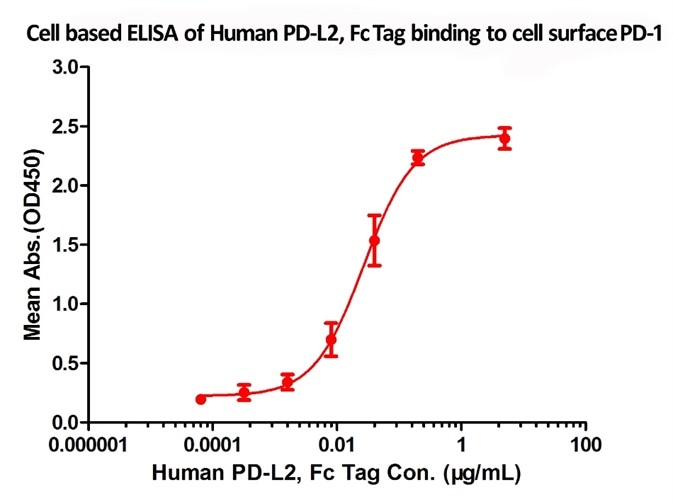
Figure 5. Flow Cytometry assay shows that recombinant human PD-L2 (Cat. No. PD2-H5251) can bind to 293 cell overexpressing human PD-1. The concentration of PD-L2 used is 1µg/mL.
Validated Applicable for Screening of Neutralizing Antibody
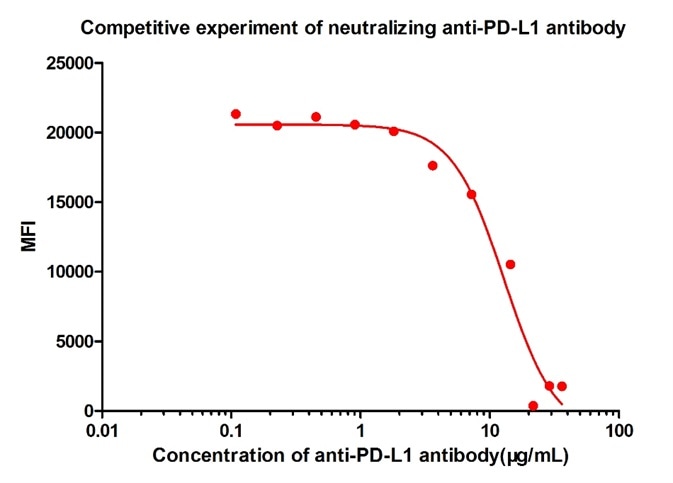
Figure 6. FACS analysis shows that the binding of PD-L1 (Cat. No. PD1-H5258) to 293 overexpressing PD-1 was inhibited by increasing concentration of neutralizing anti-hPD-L1 antibody. The concentration of PD-L1 used is 10 μg/mL. The IC50 is 12.92 μg/mL.
Cell-Based ELISA
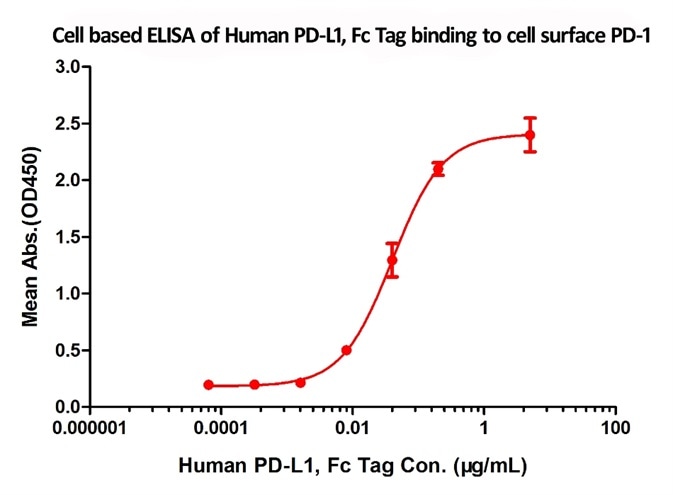
Figure 7. Immobilized cell surface PD-1 (5x104 of cells per well) can bind Human PD-L1, Fc Tag (Cat. No. PD1-H5258) with an EC50 of 0.029 μg/mL.
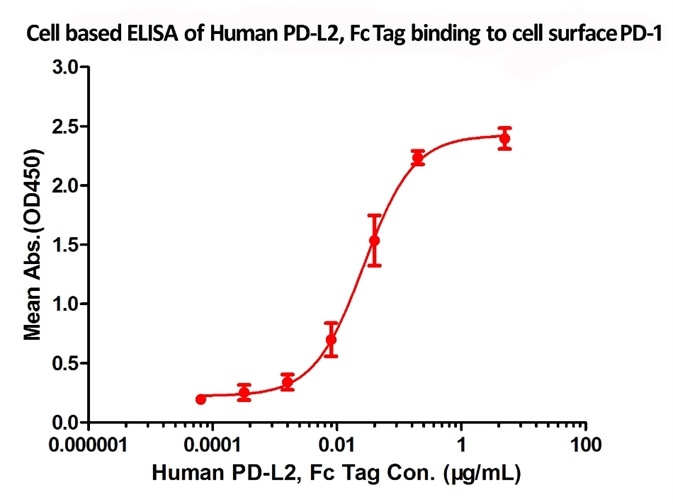
Figure 8. Immobilized cell surface PD-1 (5x104 of cells per well) can bind Human PD-L2, Fc Tag (Cat. No. PD2-H5251) with an EC50 of 0.018 μg/mL.
Latest Citations
- Hydrogel dual delivered celecoxib and anti-PD-1 synergistically improve antitumor immunit. Authors: Li Y, et al. Journal: Oncoimmunology Application: ELISA Product: PD1-M5228 Request for Full-text
- Hererocyclic compounds as immunomodulators. Authors: L Wu, et al. Journal: US20170107216A1 Application: HTRF Binding Assay Product: PD1-H5229
- Hererocyclic compounds as immunomodulators. Authors: J Li, et al. Journal: US20170145025A1 Application: HTRF Binding Assay Product: PD1-H5229
- A novel PD-L1-targeting antagonistic DNA aptamer with antitumor effects. Authors: Lai WY, et al. Journal: Mol Ther Nucleic Acids Application: ELISA-based competition assay Product: PD1-H5229
- Anti-pd-1 antibodies and methods of use thereof. Authors: Yasmina Noubia Abdiche, et al. Journal: US20160159905A1 Application: Flow Cytometry Product: PD1-H82E5
- Anti-pd-1 antibodies and methods of use thereof. Authors: Yasmina Noubia Abdiche, et al. Journal: US20160159905A1 Application: Flow Cytometry Product: PD2-H82E8
References
- Ishida Y., et al., 1992, EMBO J. 11 (11): 3887–95.
- Blank C., et al., 2007, Cancer Immunol. Immunother. 56 (5): 739–45.
- Agata Y., et al., 1996, Int. Immunol. 8 (5): 765–72.
- Freeman GJ., et al., 2000, J. Exp. Med. 192 (7): 1027–34.
- Latchman Y., et al., 2001, Nat. Immunol. 2 (3): 261–8.
- Yamazaki T., et al., 2002, J. Immunol. 169 (10): 5538–45.
- Dong H., et al., 1999, Nat. Med. 5:1365-1369.
- Freeman G.J., et al., 2000, J. Exp. Med. 192:1027-1034.
- Nishimura H., et al., 2001, Trends in Immunology 22:265.
- Tseng S.-Y., et al., 2001, J. Exp. Med. 193:839-846.
- Latchman Y., et al., 2001, Nat. Immunol. 2:261-268.
- He X.-H., et al., 2004, Acta Biochim. Biophys. Sin. 36:284-289.
ACROBiosystems
ACROBiosystems is a cornerstone enterprise of the pharmaceutical and biotechnology industries. Their mission is to help overcome challenges with innovative tools and solutions from discovery to the clinic. They supply life science tools designed to be used in discovery research and scalable to the clinical phase and beyond. By consistently adapting to new regulatory challenges and guidelines, ACROBiosystems delivers solutions, whether it comes through recombinant proteins, antibodies, assay kits, GMP-grade reagents, or custom services. ACROBiosystems empower scientists and engineers dedicated towards innovation to simplify and accelerate the development of new, better, and more affordable medicine.
Sponsored Content Policy: News-Medical.net publishes articles and related content that may be derived from sources where we have existing commercial relationships, provided such content adds value to the core editorial ethos of News-Medical.Net which is to educate and inform site visitors interested in medical research, science, medical devices and treatments.